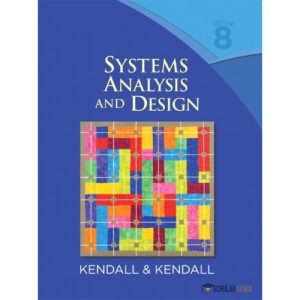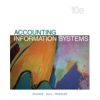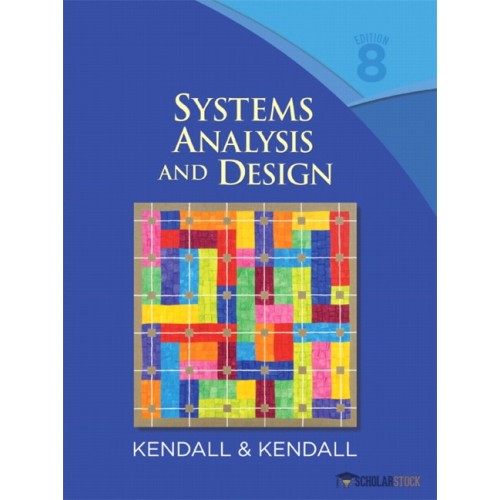Test Bank for Systems Analysis and Design 8th Edition: Kendall
$58.00 Original price was: $58.00.$29.99Current price is: $29.99.
Test Bank for Systems Analysis and Design 8th Edition: Kendall
Test Bank for Systems Analysis and Design 8th Edition: Kendall

Product details:
- ISBN-10 : 013608916X
- ISBN-13 : 978-0136089162
- Author: Kendall
Kendall and Kendall’s Systems Analysis and Design, 8e, is a human-centered book that concisely presents the latest systems development methods, tools, and techniques to readers in an engaging and easy-to-understand manner. The eighth edition highlights the latest advancements in the rapidly changing Information Systems field.
Table contents:
Part 1 Planning Phase
1 The Systems Analyst and Information Systems
Development, 3
Introduction, 4
The Systems Analyst, 6
Systems Analyst Skills, 6
Systems Analyst Roles, 7
The Systems Development Life Cycle, 8
Planning, 10
Analysis, 11
Design, 12
Implementation, 12
Project Identification and Initiation, 13
System Request, 15
Applying the Concepts at DrōnTeq, 16
Feasibility Analysis, 19
Technical Feasibility, 20
Economic Feasibility, 21
Organizational Feasibility, 27
Applying the Concepts at DrōnTeq, 29
Chapter Review, 31
Appendix 1A: Detailed Economic Feasibility
Analysis for DrōnTeq, 35
2 Project Selection and Management, 37
Introduction, 38
Project Selection, 39
Applying the Concepts at DrōnTeq, 40
Creating the Project Plan, 41
Project Methodology Options, 42
Selecting the Appropriate Development Methodology, 49
Contents
Dennis8e_ftoc.indd 11 6/30/2021 9:16:30 AM
xii Contents
Staffing the Project, 52
Staffing Plan, 52
Coordinating Project Activities, 55
Managing and Controlling the Project, 58
Refining Estimates, 58
Managing Scope, 60
Timeboxing, 60
Managing Risk, 61
Applying the Concepts at DrōnTeq, 62
Staffing the Project, 63
Coordinating Project Activities, 64
Chapter Review, 65
Part 2 Analysis Phase
3 Requirements Determination, 71
Introduction, 72
The Analysis Phase, 72
Requirements Determination, 74
What Is a Requirement?, 74
The Process of Determining Requirements, 78
The Requirements Definition Statement, 78
Requirements Elicitation Techniques, 80
Requirements Elicitation in Practice, 80
Interviews, 81
Joint Application Development (JAD), 88
Questionnaires, 92
Document Analysis, 94
Observation, 96
Selecting the Appropriate Techniques, 96
Requirements Analysis Strategies, 98
Problem Analysis, 98
Root Cause Analysis, 98
Duration Analysis, 100
Activity-Based
Costing, 100
Informal Benchmarking, 100
Outcome Analysis, 101
Technology Analysis, 101
Activity Elimination, 102
Comparing Analysis Strategies, 103
Applying the Concepts at DrōnTeq, 103
Eliciting and Analyzing Requirements, 103
Requirements Definition, 104
System Proposal, 104
Chapter Review, 106
Dennis8e_ftoc.indd 12 6/30/2021 9:16:30 AM
Contents xiii
4 Understanding Processes with Use Cases and Process
Models, 111
Introduction, 112
What Is a Use Case?, 113
The Use Case Concept in a Nutshell, 113
Use Case Formats and Elements, 114
Casual Use Case Format, 114
Use Cases in Sequence, 117
Applying Use Cases, 118
Use Case Practical Tips, 118
Use Cases and Functional Requirements, 119
Use Cases and Testing, 119
Creating Use Cases, 120
Identify the Major Use Cases, 120
Identify the Major Steps for Each Use Case, 122
Identify Elements within Steps, 125
Confirm the Use Case, 128
Revise Functional Requirements Based on Use Cases, 129
Applying the Concepts at DrōnTeq, 129
Identifying the Major Use Cases, 129
Elaborating on the Use Cases, 130
Data Flow Diagrams, 134
Reading Data Flow Diagrams, 134
Elements of Data Flow Diagrams, 136
Using Data Flow Diagrams to Define Business Processes, 139
Process Descriptions, 142
Creating Data Flow Diagrams, 144
Creating the Context Diagram, 145
Creating Data Flow Diagram Fragments, 146
Creating the Level 0 Data Flow Diagram, 148
Creating Level 1 Data Flow Diagrams (and Below), 149
Validating the Data Flow Diagrams, 152
Applying the Concepts at DrōnTeq, 156
Developing the Process Model, 156
Creating Data Flow Diagram Fragments, 156
Creating the Level 1 Data Flow Diagram, 157
Creating Level 2 Data Flow Diagrams (and Below), 159
Validating the Data Flow Diagrams, 160
Chapter Review, 161
5 Data Modeling, 169
Introduction, 170
The Entity Relationship Diagram, 170
Reading an Entity Relationship Diagram, 171
Elements of an Entity Relationship Diagram, 172
The Data Dictionary and Metadata, 177
Dennis8e_ftoc.indd 13 6/30/2021 9:16:30 AM
xiv Contents
Creating an Entity Relationship Diagram, 179
Building Entity Relationship Diagrams, 179
Advanced Syntax, 182
Applying the Concepts at DrōnTeq, 184
Validating an Entity Relationship Diagram, 188
Design Guidelines, 188
Normalization, 191
Balancing Entity Relationship Diagrams with Data Flow Diagrams, 191
Chapter Review, 193
Appendix 5A: Normalizing The Data Model, 196
6 Moving into Design, 201
Introduction, 202
Transition from Requirements to Design, 202
System Acquisition Strategies, 204
Custom Development, 206
Packaged Software, 207
Outsourcing, 208
Influences on the Acquisition Strategy, 211
Business Need, 211
People also search:
Systems Analysis and Design
Systems Analysis and Design Kendall
Systems Analysis and Design Kendall 8th
Systems Analysis and Design Kendall 8th Test Bank
Test Bank for Systems Analysis and Design, 8th Edition: Kendall Download












